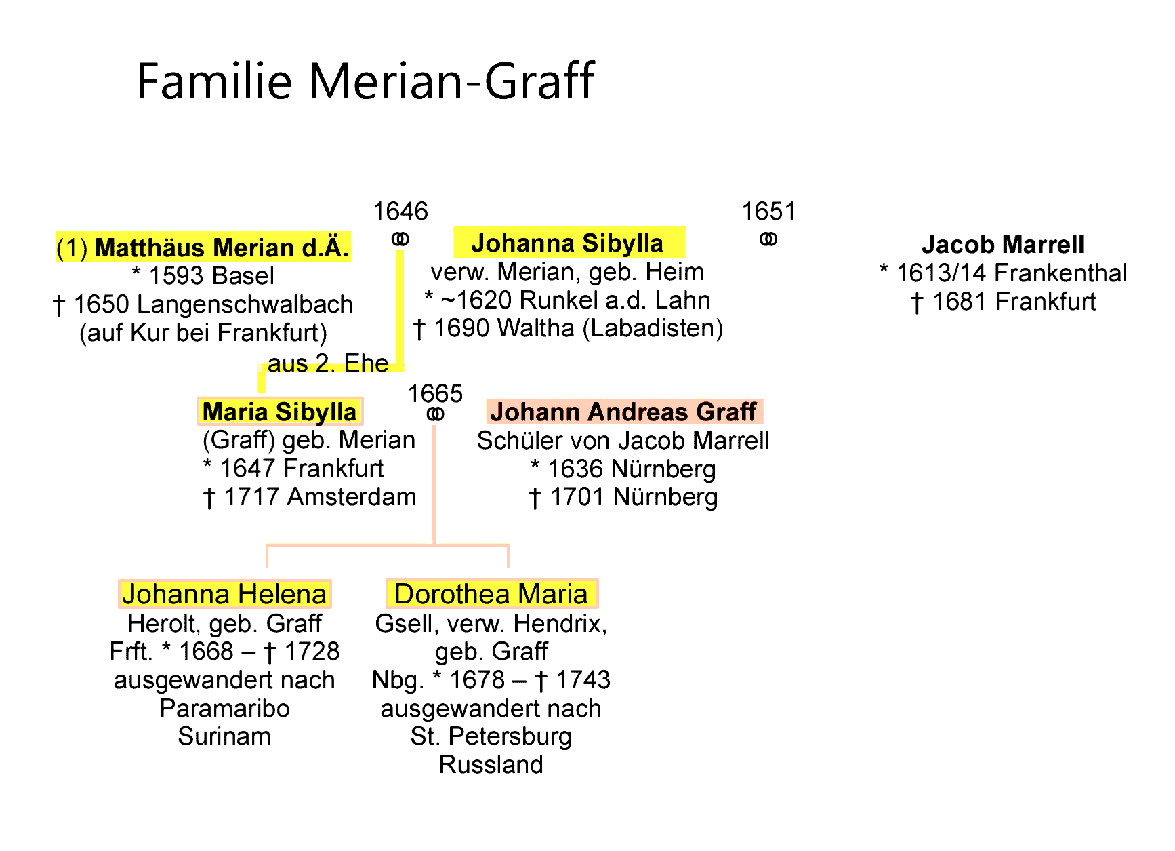PARENTS M. S. MERIAN AND J. A. GRAFF WITH THEIR DAUGHTERS
Matthäus Merian the Elder, the famous draughtsman, etcher and publisher from Basel, died in Frankfurt in 1651 and left behind a large family: the six children from his first marriage who reached adulthood are depicted together with their parents (portrait 1 + 2) in the densely populated painting that his eldest son, Matthäus Merian the Younger (portrait 3), painted around 1641.
The parents, respectfully painted in robes which suggest Antiquity, form the focus. Pointing his hand at himself, the young painter stands next to them on the left edge of the picture. In the centre sits his mother Maria Magdalena, née de Bry (1598-1645), his father's first wife. The second eldest son, Caspar (portrait 6), shows off his latest work in the middle. He was married to a woman from Nuremberg and probably worked from Nuremberg on templates and copy sources for his father's great topographic works. After the father's death he took over the workshop and publishing house in Frankfurt together with his eldest brother.
Caspar stayed in contact with Maria Sibylla throughout his life. In wills from the various phases in his life he also made bequests to his younger half-sister. He spent the last years of his life on the Waltha Estate in Frisia in the reformed, rural community of the Labadists, where Maria Sibylla also moved with her daughters and her old mother in 1686, the year of his death. It is not known whether she found her blind half-brother Caspar still alive there.
The family tree above the oil painting also contains information on the four other children of Matthäus Merian the Elder, those from his first marriage, i.e., the half-siblings to Maria Sibylla. A lifelong relationship existed with, in particular, the descendants of Maria Magdalena (no. 7 in the family portrait), the daughter from his first marriage (on right margin) and with the Graff-Merianin couple, as can be seen in the lower part of the family tree. The family ties which existed between this daughter's son-in-law and Merian the Elder’s youngest daughter, Maria Sibylla, as well as the husbands, i.e., between Johann Andreas Graff and Johann Ulrich Kraus, were closely interwoven with professional co-operation far beyond Frankfurt.
In 1649 Maria Magdalena Merian, Maria Sibylla’s half-sister and older than her by eighteen years (family portrait, far right), had married Melchior Küs(s)el. (2) Küsel was a former apprentice and journeyman of the elder Merian, after whose death he had left the workshop with a severance payment. (3) Together with his young wife he returned to his native city of Augsburg. There he and his brother Melchior Küsel trained not only journeymen but also several daughters as skilled etchers. The eldest, Johanna Sibylla, was even in a position to manage her father’s successful workshop for two years following his death. It was not until 1685, with the marriage of the 35-year-old Johanna Sibylla to the 30-year-old Johann Ulrich Kraus, that the workshop had a new master (family tree, lower part on the right side). As one of her father’s pupils Kraus was no newcomer and he was considered one of the best copper etchers of his time. (4) His wife also continued to work as an etcher and her husband even praised her in a book - black on white! (5)
After Graff had been rejected by the Labadist community in Waltha and after his return to Nuremberg, he had his excellent cityscapes etched in Kraus's Augsburg workshop for the rest of his professional life. Thus, for the next decade and a half, Graff’s drawings were in the best of hands with regard to etching and printing. We may wonder how large a part the Merian granddaughter Johanna Sibylla in Augsburg played in transforming Graff’s works from drawings into copper etchings. In one of her letters Maria Sibylla calls Kraus "our good friend". (6)
In addition to this Johanna Sibylla, two other sisters and a female cousin are named at the bottom right of the family tree. All of them received a thorough professional education (without a formal apprenticeship contract). As was common at the time, they worked in the family business for decades and contributed considerably to the family income. However, Maria Sibylla's development from an artist supported by her stepfather in Frankfurt and her husband in Nuremberg into a world-famous artist who conducted her own research and was an independent businesswoman in Amsterdam was exceptional around 1700.
Unfortunately, no such family portrait of Matthäus Merian with his second wife and their daughter Maria Sibylla is known; we only know various dates from their lives which we can compile into a family tree:
Matthäus Merian the Elder died only three years after the birth of his daughter Maria Sibylla. One year later (1651) his widow Johanna Sibylla married Jakob Marrell from Frankenthal (85 km south of Frankfurt), who was also widowed and brought his own children into the marriage. He was a recognized flower painter and art dealer and ran his own workshop. Johann Andreas Graff began his apprenticeship here in 1653 at the age of sixteen and stayed in Marrell’s workshop till 1658. After that he went on a six-year journey to Italy to work and learn everything that was new and trendy in art at that time. After his return, the 29-year-old Johann Andreas and the 18-year-old Maria Sibylla were married in 1665.
The two family tree tables outline the family context within which research has long been conducted on the Merian family and especially on their ancestor Matthäus Merian the Elder. Experts have collected and interpreted many facts. The youth in Frankfurt of his famous youngest daughter Maria Sibylla and her last, great, successful period of life in Amsterdam have also been investigated. Only her time in Nuremberg Only her Nuremberg period was long time neglected. This is also true of her own small, “nuclear family” in Nuremberg, i.e., her husband, the architectural painter, etcher and publisher Johann Andreas Graff, and their two daughters, who were likewise artistically gifted and industrious.
Johann Andreas Graff was completely forgotten for a long time. Probably the historical sources had not yet been sufficiently researched and the Nuremberg period of Maria Sibylla Merian's life was therefore particularly open to imaginative embellishment in "historical novels". Thus, for dramatic effect the radiant heroine was confronted with an allegedly incompetent, underachieving, alcoholic and sometimes even violent husband in a cramped and narrow-minded provincial town.
But that can now change because, in the run-up to the commemoration of the three-hundredth anniversary of Merian's death, her medium-term Nuremberg companion also came into focus (see below: extract from the essay in the Mitteilungen der Nürnberger Altstadtfreunde 2017). In Nuremberg the Merian Jubilee Year 2017 was also the year of the rediscovery of Johann Andreas Graff as a "pioneer of Nuremberg city views". Immediately following a very worthwhile exhibition "MARIA SIBYLLA MERIAN - Flowers, Caterpillars, Butterflies" in the Art Cabinet of Nuremberg City Library, an exhibition on the work of Johann Andreas Graff took place there in early summer 2017 - the first presentation of his copperplate prints and drawings more than 300 years after his death. The extensive catalogue is still available in some bookshops in Nuremberg. In the meantime, this temporary presentation of his works has even been developed into a permanent virtual double exhibition on Google Arts & Culture – the first of its kind with exhibits from the art collections of the Nuremberg Municipal Museums.
Johann Andreas Graff has come back from oblivion into the field of vision and is once again becomes - as in his lifetime - a "pioneer" with his city views. The presentation of his works in digital form, available all over the world, is the prelude to a new initiative by the City of Nuremberg: in the future, other art treasures from the city's museums will also be shown on the Internet worldwide.
The two daughters had a similar fate: Until the exhibition “Merian & Daughters – Women of Art and Science” in the Rembrandt House in Amsterdam and in the Getty Museum in Los Angeles in 2008, little was known about the artistic work of the daughters together with their mother. In her superb monograph (7), originally published in Dutch, its curator Ella Reitsma entitled one chapter “Familiebedrijf” (8), i. e. “The Family Firm”. During her many years of research, the author succeeded in distinguishing the “hands” of the daughters and of the mother in watercolours, i.e., in recognising their own, typically individual ways of painting. (9) This innovative study has unfortunately never been published in German and the English translation has long been out of print.
Johanna Helena grew up in Nuremberg and Dorothea Maria, was born in Nuremberg. Both daughters were her mother's most important collaborators and each in her own way contributed much to their mother’s successful life work. Therefore, two short chapters are dedicated to them here, which can be clicked on at the end of this page.
As adults, both sisters gathered more intensive experience in foreign worlds than their mother did on her two-year expedition to Suriname (the first major adventurous journey for the young Dorothea Maria). The contemporary map below, printed by the “Homann Offizin” (printers’ and publishers’ workshop) in Nuremberg which then enjoyed European acclaim, shows how far apart (around 9,200 kilometres) the two sisters and their families lived for decades. They may never have met again. We do not know whether they stayed in touch by letter.
In posterity they not only remain closely linked as irreplaceably important collaborators of their mother, but are also remarkable as artists in their own right: Johanna Helena as a specialist on plants, (10) Dorothea Maria on animals. (11) Without their variations “by their own hands”, there would not be the wealth of Merianin works in museums and private collections today.





